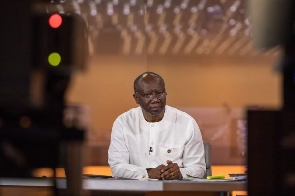 Finance Minister, Ken Ofori-Atta
Finance Minister, Ken Ofori-Atta
Economic growth slows to near four-year low in Q1
The economy lost traction in the first quarter of this year on the back of the fallout from COVID-19, with GDP growth slowing from 7.9% year-on-year in Q4 2019 to a near four-year low of 4.9%. Meanwhile, the economy grew 1.2% over the prior quarter on a seasonally-adjusted basis, down from the over two-year high of 1.9% in the prior quarter.
The slowdown in annual growth was primarily driven by markedly softer expansions in the agricultural and industrial sectors, with growth easing to 2.8% yoy (Q4: +6.8% yoy) and 1.5% yoy (Q4: +5.4% yoy) respectively.
The agricultural sector was weighed on by contracting activity in the forestry and logging subsector, while the locust plague likely harmed the production of food—a key export product.
Activity in the industrial sector was dragged on by weaker construction, while manufacturing and mining and quarrying output growth eased amid government-imposed restrictive measures since mid-March to contain the spread of Covid-19, and soft global demand for oil.
Activity eased less sharply in the services sector, which remained the main growth engine in Q1, with growth dipping from 11.0% in Q4 to 9.5% in Q1.
Looking ahead, the economy is expected to decelerate notably this year on the back of weak foreign demand for oil and low oil prices, as well as moderating domestic demand due to local containment measures and job losses.
The vulnerability of the external sector and government finances on volatile commodity prices, and a possible prolonged viral outbreak cloud the outlook further.
FocusEconomics Consensus Forecast panelists project GDP to expand 1.1% in 2020, which is unchanged from last month’s forecast. In 2021, panelists expect GDP to grow 5.7%.
PMI rises in May but remains in contractionary territory
Business conditions in Ghana’s private sector deteriorated in May, albeit at a softer pace compared to April. The IHS Markit Ghana Purchasing Managers’ Index (PMI) rose to 46.7 from April’s all-time low of 31.7.
Consequently, the headline figure remained south of the neutral 50-threshold that signals an overall decrease compared to the prior month.
The uptick in May was driven by softer falls in output and new orders as lockdown measures were gradually lifted. However, employment dropped markedly due to weakened demand, with customers reluctant to spend over worries around the pandemic.
Turning to prices, input costs were unchanged as materials shortages were offset by lower demand for inputs. On the other hand, output prices rose marginally. Lastly, business confidence rebounded and reached its highest level since November 2018.
Andrew Harker, economics director at IHS Markit, commented: “The data raise hopes that a return to growth in the economy may even be seen in June, while companies themselves are at their most optimistic for a year-and-a-half.”
FocusEconomics panelists see fixed investment contracting 8.0% in 2020. In 2021, fixed investment is expected to rebound and grow 5.3%.
Inflation on the rise
Consumer prices increased 1.7% over the last month in May, coming in below the 3.2% rise logged in April. The print was driven by a marked increase in housing, water, electricity and gas prices as well as higher prices for food and non-alcoholic beverages. On the other hand, falling transport and health prices limited the monthly increase.
Inflation rose to 11.3% in May, above April’s 10.6%. Annual average inflation increased to 8.6% in May (April: 8.4%).
Although the COVID-19 pandemic has resulted in stronger food price inflation, inflation overall is expected to moderate going forward due to weakened aggregate demand weighing on price pressures.
FocusEconomics Consensus Forecast panelists expect inflation to average 8.8% in 2020. In 2021, they see inflation averaging 8.6%.